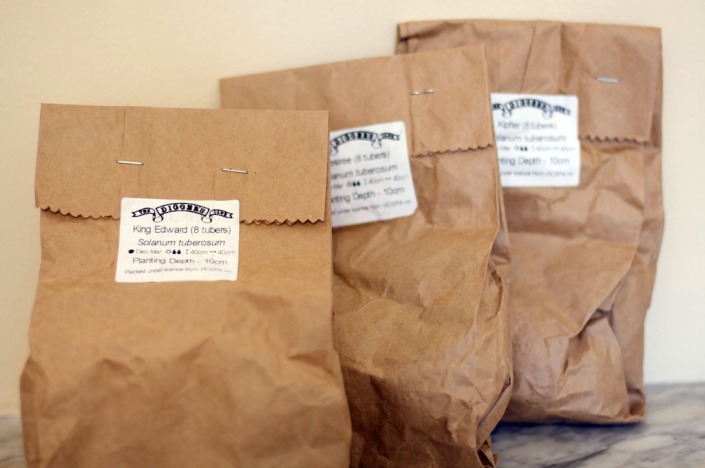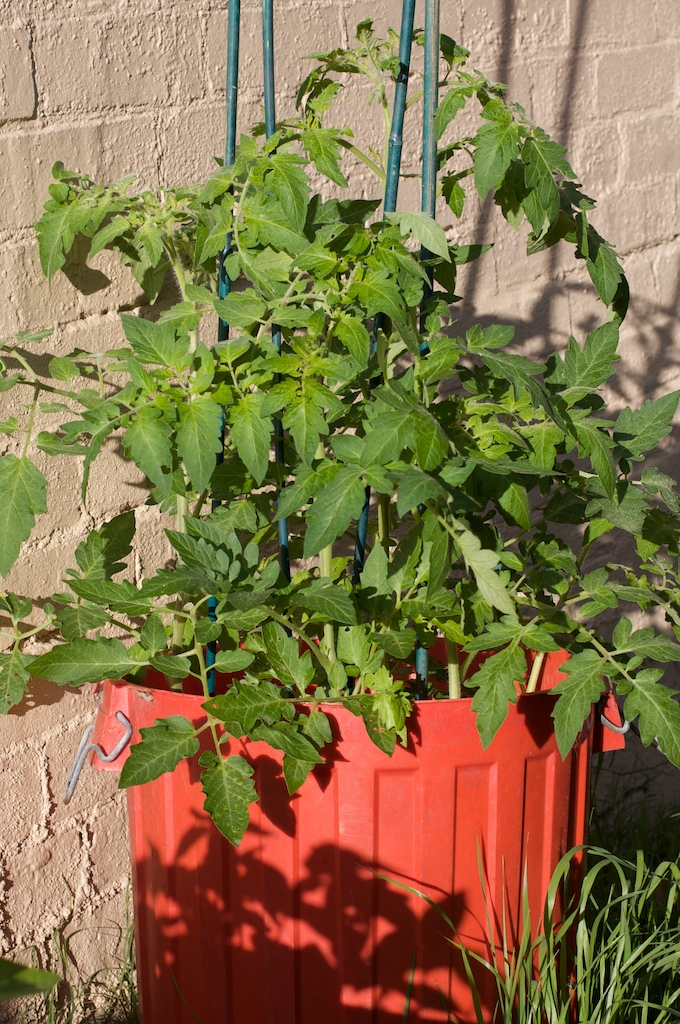Month: June 2009
Our first pak choy

The red pak choy was one of the first things we planted into the garden, and it grew at a huge rate at the outset. Then the rain and cold weather hit, and everything slowed almost to a halt. Still, I’ve been keeping my eye on the pak choy, and tonight was the night.
We did a simple Thai-style stir fry of pak choy, snow peas and sugar snap peas (all out of the garden). Quickly tossed with chilli, fish sauce and lime juice. Served with noodles, yum!
Still plenty of pak choy left, ready to harvest whenever the mood strikes.
Potatoes in the ground

One of the things that I really wanted to try in our first year of gardening was potatoes. So I placed an order with Diggers Club, and six (long!) weeks later I had:
- 8 x Kipfler seed potatoes
- 8 x King Edward seed potatoes
- 8 x Desiree seed potatoes
Now, on reading the notes that came with the potatoes, I quickly realised that I’ve probably ordered too many. Way too many! Apparently each seed potato will generate 10 new potatoes, making 240 potatoes in total. That’s a lot of potatoes.
No matter, better more than less 🙂
Now all that was needed was somewhere to put the potatoes; cue another garden bed. Luckily I rode past some workmen cutting up an old (and somewhat rotted) paling fence, and they were very happy for me to take away what would otherwise be going to the tip.
One car trip later, I pulled together the following supplies:
- Four pieces of 50×50 treated pine, recycled from under the house and cut into 600mm lengths
- 24 recycled fence palings, roughly 2m in length
- weatherproofed phillips head screws
The result was a large 2m x 2m garden bed, with the ability to add extra planks to raise the height of the sides as the potatoes grow. That should increase the size of the harvest.

Now came the tricky part, preparing and planting the garden bed. Reading up, I obtained a number of different pieces of advice, not all matching up. If in doubt: make it up, and hope for the best.
This is what I decided to do in the end:
- thick layer of newspaper
- layer of straw
- thin layer of soil and compost
- potatoes, at 40cm x 40cm spacings
- mix of soil, compost, straw and cow mature to a depth of 10cm
Now to wait, and hope for the best. I’ll post another photo when the potatoes have sprouted.
Guerrilla gardening in the U.S.: flyer boxes
 I found a blog post this week about a guerrilla gardener in the U.S. who has converted a flyer box into a planter box.
I found a blog post this week about a guerrilla gardener in the U.S. who has converted a flyer box into a planter box.
I’m not sure how sustainable it is (what happens if somebody closes the box???) but it’s a cute idea nevertheless.
Proposed staff cuts to Lewisham train station
Although this is a little off-topic, we want to let all locals know about the proposed staff cuts to Lewisham train station.
Basically, the NSW government is allowing RailCorp to cut staff at train stations and Lewisham station is one of those listed for cuts. This will result in:
- Reduced levels of customer service. I have spoken with the various staff at Lewisham station and they have told me the station will be staffed from 6am – 8pm Monday to Friday under the proposed changes. There will be NO STAFF ON WEEKENDS OR EVENINGS. Too bad if you don’t have change for the one ticket machine.
- Limited or no assistance for elderly passengers, disabled passengers and parents with prams. At Lewisham station, too get to the platform you have to go up a flight of stairs. Try doing that with a pram by yourself!
- Longer ticket queues. If you catch the train on Monday or Tuesday mornings you will have an understanding of the chaos at Lewisham during these peak periods (there is only one ticket machine and one ticket window … I have missed trains while queuing for a ticket on a Monday morning). If an accident happens at the station during these peak periods, the station will be chaos as there will only be one staff member at the station to deal with issues.
- Poorer security, particularly during evenings and weekends when there will be no staff around. I don’t know about you, but I feel safer knowing there’s always someone in the ticket office at the station.
YOU CAN HELP by contacting our local member, Carmel Tebbutt, and registering your protest:
Phone: 9228 4866
Email: dp.office@tebbutt.minister.nsw.gov.au
Please don’t be apathetic about this … your phone call will make a difference!
The harvesting has begun

The obvious milestone for starting a new vege garden is the first harvest, straight from the garden to the plate. While everything grew rapidly during autumn, the cold snap over the last week has definitely slowed things up.
Still, this was a good week for home-grown food:
Last Sunday: a handful of tuscan kale, sauteed with butter, garlic, verjuice and parmesan. A perfect side-dish with lemony chicken!
During the week: the first small handful of snow peas, stored up for eating tonight.
Today: a generous basket of silverbeet, english spinach and tuscan kale. All of which will be going into spanakopita (cheese and spinach pie). Can’t wait!

I’m hoping that by next weekend we’ll have a good crop of sugar snap peas, more snow peas, and pak choy. Then tomatoes and further silverbeet.

Grants for community gardens
The Open Garden scheme has just announced details on their 2009 grants program for community gardens. This gives cash to community gardens across Australia that are of ” lasting benefit to the local and wider community” and are “accessible to the public on a permanent or semi-permanent basis”.
I think it’s wonderful that there is money available for these gardens. At this point we’re pretty busy on our own private garden, so I don’t think we’ll be applying this year. 🙂
There are also plenty of good inner-West community gardens nearby (but you can’t have too many!).
Serendipity and tomatoes

We we moved, we had some left over soil and compost in an old garbage bin. I left this beside the side of the house, and thought nothing more of it.
Until tomato shoots starting poking their heads up. This is pretty normal: we have tomatoes appearing out of our compost at the drop of a hat. This was a particularly good effort though, growing in a bin whose contents are in permanent shade, coming into winter.
Apparently no-one told these tomatoes that they’re out of season. So I thought I’d help them along with some garden stakes, and I’m wonding what kind of tomatoes they’ll turn out to be…
Free local food (it’s legal … really!)
A friend of mine, Trina, has a great blog called Greenfoot. Recently, Trina created a feral fruit tree map using Google maps which shows where fruit can be picked (legally) in her local area of Ryde.
I love this idea! We used to live in Chippendale, just around the corner from Myrtle Street. Myrtle Street is well-known for the produce plantings down the nature strip. All local residents of Chippendale are welcome to share – and are encouraged to maintain – the produce.
However, I don’t walk around our current neighbourhood of Lewisham enough, so I don’t know about places where I could pick local fruit and other useful plants (however, there does happen to be a Bay tree outside our house that is a free-for-all!). If you know about local plants that can be shared — be they lemon myrtle (great in tea!), fruits, or other delicacies please share with us all by leaving a comment below!
Growing from seed

A lot of what we’ve grown has been from seed, rather than seedlings. What has been interesting is that plants from seeds have consistently grown quicker and stronger than seedlings. For example, our sugar snap peas from seeds are gowing incredibly, while the seedlings of snow peas from the local garden store have barely moved (very disappointing).
Dollar-for-dollar, you can’t beat seeds. At $2-4 per packet, that’s the price of a single vegetable from many supermarkets. Packets contain 50-200 seeds, depending on the variety. This may seem a lot (it is!), but it gives plenty to share around with neighbours, or to trade for other seeds.
Most seeds last for 2 years, giving a good chance to get value out of them. I’ve also been lazy: instead of planting in punnets, I’ve sown seeds directly into the ground, with complete success. (No doubt this is due to the warm Sydney climate.)
There are many suppliers of seeds in Australia, mostly organic, including:
- Diggers Club (the source of most of our seeds to this point, but extremely slow to process orders in recent times)
- Greenpatch Organic Seeds (have just received our first order in under 4 working days, will be ordering from them again!)
- Eden Seeds
- The Italian Gardener
- The Lost Seed
- Tasmanian Gourmet Potatoes
Note that a lot of these suppliers concentrate on heirloom seeds, old varieties no longer seen on supermarket shelves. These are great, well adapted to local conditions, and often both tasty and unusual. Seek these out wherever possible!
Where have you been getting your seeds from?